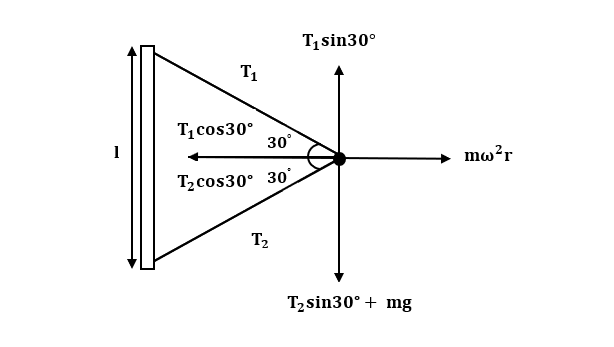
A particle P of mass m attached to a vertical axis by two strings AP and BP of length 1 m each. The separation AB= l. P rotates around the axis with an angular velocity $\omega$. The tension in the two strings are ${T}_{1}$ and ${T}_{2}$. Then,
(This question has multiple correct answers)

A. ${T}_{1}={T}_{2}$
B. ${T}_{1}+{T}_{2}=m {\omega}^{2} l $
C. ${T}_{1}-{T}_{2}= 2mg $
D. BP will remain taut only if $ \omega \geq \sqrt {\dfrac {2g}{l}}$

Answer
443.7k+ views
Hint: To solve this question first find the balancing forces in vertical direction. Then, find the balancing forces in horizontal direction. These balancing forces will be in terms of tension in the string. Then, subtracting these two equations. But the tension in the string along BP has to be greater than zero. So, substitute this condition and find the value for angular velocity.
Complete answer:

Let tension along AB and BP be ${T}_{1}$ and ${T}_{2}$ respectively.
All the sides of the triangle ABP are of the same length. Hence, it is an equilateral triangle and thus, all the angles are the same.
$\angle PAB= \angle ABP= \angle BPA= 60°$
Balancing the forces in vertical direction we get,
${T}_{1}\sin{30°}= {T}_{2}\sin{30°} + mg$
$\Rightarrow {T}_{1}\sin{30°}- {T}_{2}\sin{30°}= mg$
$\Rightarrow \sin{30°} ({T}_{1}-{T}_{2})= mg$
$\Rightarrow \dfrac {1}{2} ({T}_{1}-{T}_{2})= mg$
$\Rightarrow{T}_{1}-{T}_{2}= 2mg$ …(1)
Now, P rotates around the axis with an angular velocity $\omega$. Thus, the forces in horizontal direction is given by,
${T}_{1}\cos{30°}+{T}_{2}\cos{30°}= m{\omega}^{2}r$ …(2)
But, the radius of rotation is given by,
$r= l\cos{30°}$
Substituting above value in equation. (2) we get,
${T}_{1}\cos{30°}+ {T}_{2}\cos{30°}= m{\omega}^{2} l\cos{30°}$
$\Rightarrow \cos{30°} ({T}_{1}+{T}_{2})= m{\omega}^{2} l\cos{30°}$
$\Rightarrow {T}_{1}+{T}_{2}=m {\omega}^{2} l$ …(3)
Subtracting equation. (2) from equation. (3) we get,
${T}_{1}+{T}_{2}- {T}_{1}-{T}_{2}= m {\omega}^{2} l-2mg$
$\Rightarrow 2{T}_{2}= m {\omega}^{2} l-2mg$
To BP to remain taut, ${T}_{2}$ should be greater than zero.
$ m {\omega}^{2} l-2mg > 0$
$\Rightarrow m {\omega}^{2} l \geq 2mg$
$\Rightarrow {\omega}^{2} \geq \dfrac {2mg}{ml}$
$\Rightarrow {\omega}^{2} \geq \dfrac {2g}{l}$
$\Rightarrow \omega \geq \sqrt {\dfrac {2g}{l}}$
Hence, the correct answers are option B, C and D.
Note:
To solve these types of problems, students must analyze the figure and draw the free body diagram first. To draw an appropriate free body diagram, they should know the definition of it. Free body diagrams are diagrams used to show the relative magnitude and direction of all forces acting on the particle or an object in a given situation. It is also known as force diagram as it shows proper position and direction of forces.
Complete answer:

Let tension along AB and BP be ${T}_{1}$ and ${T}_{2}$ respectively.
All the sides of the triangle ABP are of the same length. Hence, it is an equilateral triangle and thus, all the angles are the same.
$\angle PAB= \angle ABP= \angle BPA= 60°$
Balancing the forces in vertical direction we get,
${T}_{1}\sin{30°}= {T}_{2}\sin{30°} + mg$
$\Rightarrow {T}_{1}\sin{30°}- {T}_{2}\sin{30°}= mg$
$\Rightarrow \sin{30°} ({T}_{1}-{T}_{2})= mg$
$\Rightarrow \dfrac {1}{2} ({T}_{1}-{T}_{2})= mg$
$\Rightarrow{T}_{1}-{T}_{2}= 2mg$ …(1)
Now, P rotates around the axis with an angular velocity $\omega$. Thus, the forces in horizontal direction is given by,
${T}_{1}\cos{30°}+{T}_{2}\cos{30°}= m{\omega}^{2}r$ …(2)
But, the radius of rotation is given by,
$r= l\cos{30°}$
Substituting above value in equation. (2) we get,
${T}_{1}\cos{30°}+ {T}_{2}\cos{30°}= m{\omega}^{2} l\cos{30°}$
$\Rightarrow \cos{30°} ({T}_{1}+{T}_{2})= m{\omega}^{2} l\cos{30°}$
$\Rightarrow {T}_{1}+{T}_{2}=m {\omega}^{2} l$ …(3)
Subtracting equation. (2) from equation. (3) we get,
${T}_{1}+{T}_{2}- {T}_{1}-{T}_{2}= m {\omega}^{2} l-2mg$
$\Rightarrow 2{T}_{2}= m {\omega}^{2} l-2mg$
To BP to remain taut, ${T}_{2}$ should be greater than zero.
$ m {\omega}^{2} l-2mg > 0$
$\Rightarrow m {\omega}^{2} l \geq 2mg$
$\Rightarrow {\omega}^{2} \geq \dfrac {2mg}{ml}$
$\Rightarrow {\omega}^{2} \geq \dfrac {2g}{l}$
$\Rightarrow \omega \geq \sqrt {\dfrac {2g}{l}}$
Hence, the correct answers are option B, C and D.
Note:
To solve these types of problems, students must analyze the figure and draw the free body diagram first. To draw an appropriate free body diagram, they should know the definition of it. Free body diagrams are diagrams used to show the relative magnitude and direction of all forces acting on the particle or an object in a given situation. It is also known as force diagram as it shows proper position and direction of forces.
Recently Updated Pages
Glucose when reduced with HI and red Phosphorus gives class 11 chemistry CBSE

The highest possible oxidation states of Uranium and class 11 chemistry CBSE

Find the value of x if the mode of the following data class 11 maths CBSE

Which of the following can be used in the Friedel Crafts class 11 chemistry CBSE

A sphere of mass 40 kg is attracted by a second sphere class 11 physics CBSE

Statement I Reactivity of aluminium decreases when class 11 chemistry CBSE

Trending doubts
10 examples of friction in our daily life

The correct order of melting point of 14th group elements class 11 chemistry CBSE

Difference Between Prokaryotic Cells and Eukaryotic Cells

One Metric ton is equal to kg A 10000 B 1000 C 100 class 11 physics CBSE

State and prove Bernoullis theorem class 11 physics CBSE

What organs are located on the left side of your body class 11 biology CBSE




